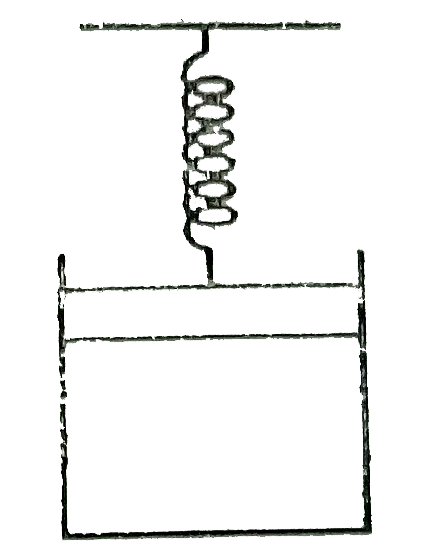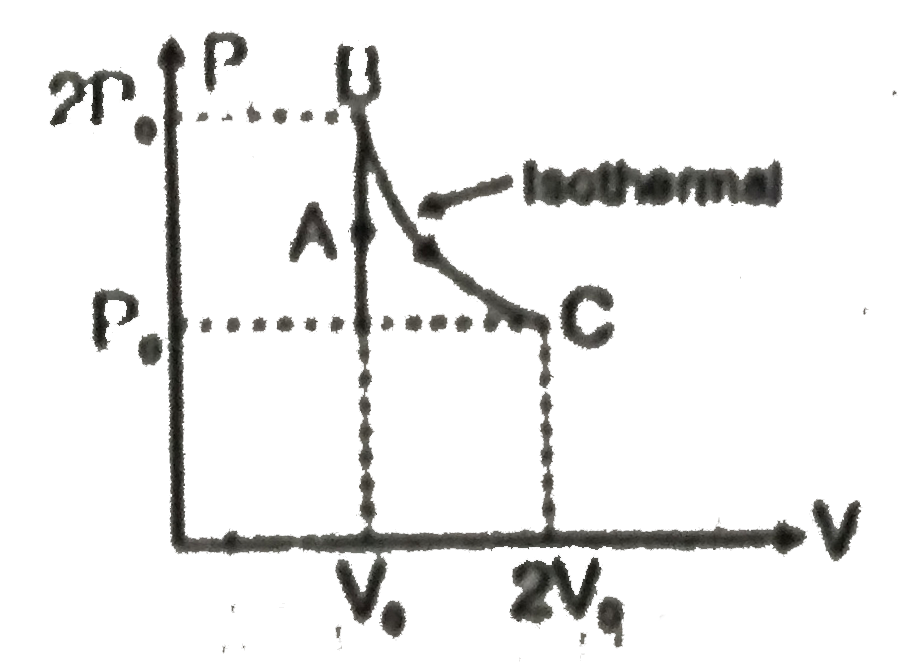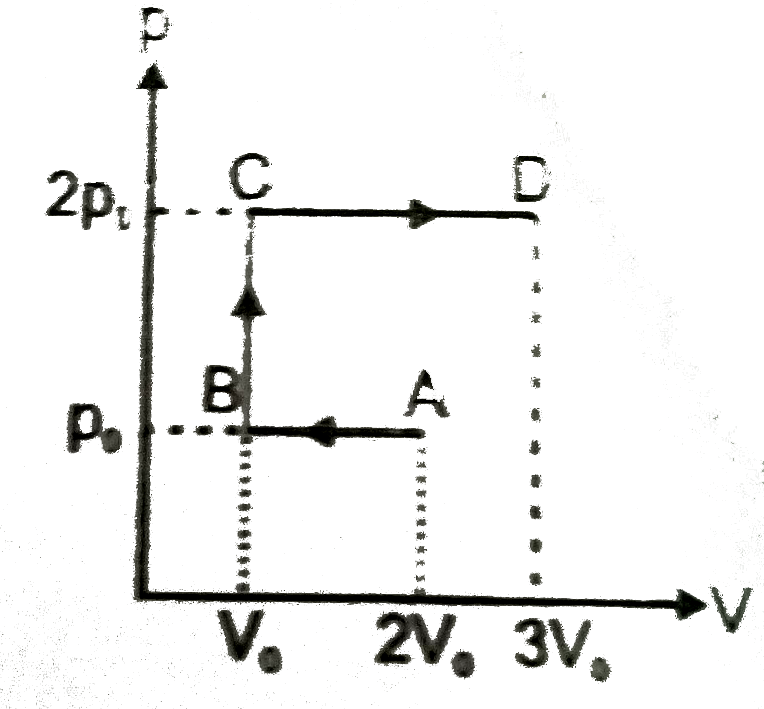Complete Solutions to PART -II of chapter KTG & THERMODYNAMICS of Class 11 book with complete answers and questions
| Class 11 | PHYSICS |
| Chapter | KTG & THERMODYNAMICS |
| RESONANCE | PART -II |
| Number Of Questions | 17 |
| Academic Year | 2023-24 |
When an ideal gas is compressed isothermally then its pressure increase because:
03:40View SolutionA vessel of volume `V = 5` litre contains `1.4 g` nitrogen and `0.4g` of He at `1500K`. If `30%` of the nitrogen molecules are disassociated into atoms then the gas pressure becomes `(N)/(8)xx10^(5)N//m^(2)`. Find `N` (Assume `T` constant). `[R = (25)/(3)J//molK]`
05:34View SolutionIn given figure, an ideal gas is trapped between a mercury column and the closed end of a uniform vertical tube. The upper end of the tube is open to the atmosphere. Initially the lengths of the mercury column and the trapped air colume are `12 cm` and `50cm` respectively. when the tube is titted solwly in a vertical plane through an angle of `30^(@)` with horizontal then the new length of air colume is `(x)/(41)m`. Find `x`. Assuming the temperature to remains constant. `(P_(atm) = 76 cm of Hg)`
 13:46View Solution
13:46View SolutionTwo vessels `A` and `B`, thermally insulated, contain an ideal monoatomic gas. A small tube fitted with a valve connects these vessels. Initially the vessel `A` has `2` litres of gas at `300K` and `2 xx 10^(5)Nm^(-2)` pressure while vessel `B` has `4` litres of gas at `350 K` and `4 xx 10^(5)Nm^(-2)` pressure. The value is now opened and the system reaches equilibrium in pressure and temperature. Calculate the new pressure and temperature . `(R = (25)/(3)J//mol-K)`
11:15View SolutionConsider a vertical tube open at both ends. The tube consistss of two parts, each of different cross sections and each part having a piston which can move smoothly in respective tubes. The two piston which can move smoothly in respective tube wire. The piston are joined together by an inextensible wire. The combined mass of the two piston is `5 kg`and area of cross section of the upper piston is `10 cm^(2)` greater than that of the lower piston. Amount of gas enclosed by the pistons is `1 mol`. When the gas is heated slowly, pistons move by `50 cm`. Find the rise in the temperature of the gas in the form `X//R K`, where `R` is universal gas constant. Use `g = 10 m//s^(2)` and outside pressure `= 10^(5) N//m^(2))`.
 10:16View Solution
10:16View SolutionWhen `2g` of gas `A` is introduced into an evacuated flask kept at `25^(@)C` the presusre is found to be `1atm`. If `3g` of another gas `B` is then added to the same flask the total pressure becomes `1.5 atm`. The ratio of molecular weights M A : M B .
05:00View SolutionTwo moles of an ideal monoatomic gas undergo a cyclic process which is indicated on a `P -U` diagram, where `U` is the internal energy of the gas. The work done by the gas in the cycle is `k xx 10^(2) In2`. Find `k`.
 13:41View Solution
13:41View SolutionIn figure, a sample of `3` moles of an ideal gas is undergoing through a cyclic process `ABCA. A` total of `1500J` of heat is withdraw from the sample in the process. The work done by the gas during the part `BC` is `-P K J. FIND P. (R = (25)/(3) J//"mole"K)`
 09:24View Solution
09:24View SolutionDuring the expansion process the volume of the gas changes form `4m^(3)` to `6m^(3)` while the pressure change according to `p = 30 V +100` where pressure is in `Pa` and volume is in `m^(3)`. The work done by gas in `N xx 10^(2)J`. Find `N`.
04:18View SolutionA balloon containing an ideal gas has a volume of `10 litre` and temperature of `17^(@)`. If it is heated slowly to `75^(@)C`, the work done by the gas inside the balloon is (neglect elasticity of the balloon and take atmospheric pressure as `10^(5)` Pa)
03:34View SolutionOne mole of an ideal gas is kept enclosed under a light piston (area `= 10^(-2)m^(2))` connected by a compresses spring (spring constant `100N//m)`. The volume of gas is `0.83 m^(3)` and its temperature is `100K`. The gas is heated so that it compresses the spring further by `0.1 m`. The work done by the gas in the process is `N xx 10^(-1)J`. Find `N`. (Take `R = 8.3 J//K-"mole")` and suppose there is no atmosphere).
 09:18View Solution
09:18View Solution`3` moles of an ideal mono atomic gas performs a cycle as shown in fig. `If` gas temperature `T_(A)=400 K` `T_(B)=800K,T_(C)=2400K`, and `T_(D)=1200K`. Then total work done by gas is
 07:22View Solution
07:22View SolutionAn adiabatic cylindrical tube is fitted with an adiabatic separator as shown in figure. Initial separator is in equilibrium and divides a tube in two equal parts. The seperator can be slide into the tube by an extermal mechanism. An ideal gas `(gamma = 1.5)` is injected in the two slides at equal pressure and temperature. Now separator is slid to a piston where it divides the tube in the ratio `7 :3` The ratio of the temperature in the two parts of the vessel is `sqrt(n) : sqrt(7)` find `n`.
 08:30View Solution
08:30View SolutionA diatomic ideal gas undergoes a thermodynamic change according to the P-V diagram shown in the figure. The total heat given to the gas is nearly ( use ln2=0.7):
 06:22View Solution
06:22View SolutionA thermodynamic process of one mole ideal monoatomic gas is shown in figure. The efficiency of cyclic process `ABCA` will be

06:57View Solution`P-V` indicator diagram for a given sample of monoatomic ideal gas is shown in figure. If the average molar specific heat capacity of the system for the process `ABCD` is `(xR)/(4)` than find value of `x:(R` is a universal gas constant)
 10:55View Solution
10:55View SolutionA thermally insulated piston divides a nonconducting container in two compartements, right compartement of `2V, T` and `2P`, while in the left compartement the respective values are `V, T` and `P`. Total moles in total system of both comartments is `5` moles. if piston can slide freely, and in the final equilibrium position, volume of right compartement is `(xV)/(5)` then find the value of `x`.
06:09View Solution
PART -II questions and complete solutions for chapter KTG & THERMODYNAMICS of RESONANCE ENGLISH of Class 11
All Exercises from RESONANCE Class 11 PHYSICS KTG & THERMODYNAMICS
- Advancel Level Problems
- Board Level Exercise
- Examples
- Exercise -1
- Exercise-2
- Exercise-3
- PART - I
- PART - II
- PART -I
- PART -II
- PART -III
- PART -IV
- Problem
- SECTION
- SECTION (A)
- SECTION (B)
- SECTION (C)
- SECTION (D)
- SECTION (E)
- SECTION (F)
- SECTION (G)
- SECTION (H)
- SECTION (I)
- SECTION (J)
- Solved Examples
- Solved problem
- SUBJECTIVE QUESTIONS
